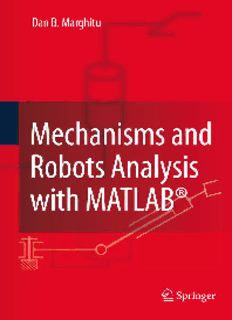
Mechanisms and Robots Analysis with MATLAB® PDF
Preview Mechanisms and Robots Analysis with MATLAB®
® Mechanisms and Robots Analysis with MATLAB Dan B. Marghitu Mechanisms and Robots ® Analysis with MATLAB 123 Dan B. Marghitu, Professor Mechanical Engineering Department Auburn University 270 Ross Hall Auburn, AL 36849 USA ISBN 978-1-84800-390-3 e-ISBN 978-1-84800-391-0 DOI 10.1007/978-1-84800-391-0 Springer Dordrecht Heidelberg London New York British Library Cataloguing in Publication Data A catalogue record for this book is available from the British Library Library of Congress Control Number: 2009920949 © Springer-Verlag London Limited 2009 MATLAB® and Simulink® are registered trademarks of The MathWorks, Inc., 3 Apple Hill Drive, Natick, MA 01760-2098, USA. http://www.mathworks.com Apart from any fair dealing for the purposes of research or private study, or criticism or review, as permitted under the Copyright, Designs and Patents Act 1988, this publication may only be reproduced, stored or transmitted, in any form or by any means, with the prior permission in writing of the publishers, or in the case of reprographic reproduction in accordance with the terms of licences issued by the Copyright Licensing Agency. Enquiries concerning reproduction outside those terms should be sent to the publishers. The use of registered names, trademarks, etc. in this publication does not imply, even in the absence of a specific statement, that such names are exempt from the relevant laws and regulations and therefore free for general use. The publisher makes no representation, express or implied, with regard to the accuracy of the information contained in this book and cannot accept any legal responsibility or liability for any errors or omissions that may be made. Cover design: eStudioCalamar, Figueres/Berlin Printed on acid-free paper Springer is part of Springer Science+Business Media (www.springer.com) toStefania,toDaniela, toValeria,toEmil Preface Mechanismsandrobotshavebeenandcontinuetobeessentialcomponentsofme- chanicalsystems.Mechanismsandrobotsareusedtotransmitforcesandmoments and to manipulate objects. A knowledge of the kinematics and dynamics of these kinematic chains is most important for their design and control. MATLAB(cid:2)R is a modern tool that has transformed the mathematical calculations methods because MATLAB not only provides numerical calculations but also facilitates analytical calculations using the computer. The present textbook uses MATLAB as a tool to solveproblemsfrommechanismsandrobots.Theintentistoshowtheconvenience ofMATLABformechanismandrobotanalysis.UsingexampleproblemstheMAT- LABsyntaxwillbedemonstrated.MATLABisveryusefulintheprocessofderiv- ingsolutionsforanyprobleminmechanismsorrobots.Thebookincludesalarge numberofproblemsthatarebeingsolvedusingMATLAB.Theprogramsareavail- ableasappendicesattheendofthisbook. Chapter 1 comments on the fundamentals properties of closed and open kine- matic chains especially of problems of motion, degrees of freedom, joints, dyads, and independent contours. Chapter 2 demonstrates the use of MATLAB in find- ing the positions of planar mechanisms using the absolute Cartesian method. The positions of the joints are calculated for an input driver angle and for a complete rotation of the driver link. An external m-file function can be introduced to calcu- late the positions. The trajectory of a point on a link with general plane motion is plotted using MATLAB. In Chap. 3 the velocities and acceleration are examined. MATLABisasuitabletooltodevelopanalyticalsolutionsandnumericalresultsfor kinematicsusingtheclassicalmethod,thederivativemethod,andtheindependent contourequations.InChap.4,thejointforcesarecalculatedusingthefree-bodydi- agramofindividuallinks,thefree-bodydiagramofdyads,andthecontourmethod. MATLABfunctionsareappliedtofindandsolvethealgebraicequationsofmotion. Problems of dynamics using the Newton–Euler method are discussed in Chap. 5. Theequationsofmotionareinferredwithsymbolicalcalculationandthesystemof differentialequationsissolvedwithnumericaltechniques.Finally,thelastchapter usescomputeralgebratofindLagrange’sequationsandKane’sdynamicalequations forspatialrobots. vii Contents 1 Introduction................................................... 1 1.1 DegreesofFreedomandMotion.............................. 1 1.2 KinematicPairs ............................................ 3 1.3 Dyads .................................................... 8 1.4 IndependentContours....................................... 10 1.5 PlanarMechanismDecomposition ............................ 10 2 PositionAnalysis............................................... 15 2.1 AbsoluteCartesianMethod .................................. 15 2.2 Slider-Crank(R-RRT)Mechanism ............................ 16 2.3 Four-Bar(R-RRR)Mechanism ............................... 20 2.4 R-RTR-RTRMechanism .................................... 27 2.5 R-RTR-RTRMechanism:CompleteRotation ................... 31 2.5.1 MethodI:ConstraintConditions ....................... 31 2.5.2 MethodII:EuclidianDistanceFunction ................. 35 2.6 PathofaPointonaLinkwithGeneralPlaneMotion............. 37 2.7 CreatingaMovie........................................... 40 3 VelocityandAccelerationAnalysis ............................... 43 3.1 Introduction ............................................... 43 3.2 VelocityFieldforaRigidBody............................... 44 3.3 AccelerationFieldforaRigidBody ........................... 46 3.4 MotionofaPointthatMovesRelativetoaRigidBody ........... 50 3.5 Slider-Crank(R-RRT)Mechanism ............................ 53 3.6 Four-Bar(R-RRR)Mechanism ............................... 60 3.7 InvertedSlider-CrankMechanism............................. 65 3.8 R-RTR-RTRMechanism .................................... 71 3.9 DerivativeMethod.......................................... 79 3.10 IndependentContourEquations............................... 95 ix x Contents 4 DynamicForceAnalysis ........................................109 4.1 EquationofMotionforGeneralPlanarMotion..................109 4.2 D’Alembert’sPrinciple......................................114 4.3 Free-BodyDiagrams........................................115 4.4 ForceAnalysisUsingDyads .................................116 4.4.1 RRRDyad..........................................116 4.4.2 RRTDyad ..........................................118 4.4.3 RTRDyad ..........................................119 4.5 ForceAnalysisUsingContourMethod.........................120 4.6 Slider-Crank(R-RRT)Mechanism ............................121 4.6.1 InertiaForcesandMoments ...........................124 4.6.2 JointForcesandDriveMoment ........................126 4.7 R-RTR-RTRMechanism ....................................147 4.7.1 InertiaForcesandMoments ...........................151 4.7.2 JointForcesandDriveMoment ........................154 5 DirectDynamics:Newton–EulerEquationsofMotion..............183 5.1 CompoundPendulum .......................................183 5.2 DoublePendulum ..........................................192 5.3 One-LinkPlanarRobotArm .................................201 5.4 Two-LinkPlanarRobotArm .................................204 6 AnalyticalDynamicsofOpenKinematicChains ...................209 6.1 GeneralizedCoordinatesandConstraints.......................209 6.2 LawsofMotion............................................211 6.3 Lagrange’sEquationsforTwo-LinkRobotArm .................213 6.4 RotationTransformation.....................................225 6.5 RRTRobotArm ...........................................228 6.5.1 DirectDynamics.....................................228 6.5.2 InverseDynamics....................................246 6.5.3 Kane’sDynamicalEquations ..........................250 6.6 RRTRRobotArm ..........................................257 7 Problems......................................................275 7.1 ProblemSet:Mechanisms ...................................275 7.2 ProblemSet:Robots ........................................291 A ProgramsofChapter2:PositionAnalysis.........................301 A.1 Slider-Crank(R-RRT)Mechanism ............................301 A.2 Four-Bar(R-RRR)Mechanism ...............................303 A.3 R-RTR-RTRMechanism ....................................306 A.4 R-RTR-RTRMechanism:CompleteRotation ...................309 A.5 R-RTR-RTRMechanism:CompleteRotationUsingEuclidian DistanceFunction ..........................................312 A.6 PathofaPointonaLinkwithGeneralPlaneMotion:R-RRT Mechanism................................................314 Contents xi A.7 PathofaPointonaLinkwithGeneralPlaneMotion:R-RRR Mechanism................................................315 B ProgramsofChapter3:VelocityandAccelerationAnalysis .........317 B.1 Slider-Crank(R-RRT)Mechanism ............................317 B.2 Four-Bar(R-RRR)Mechanism ...............................322 B.3 InvertedSlider-CrankMechanism.............................326 B.4 R-RTR-RTRMechanism ....................................331 B.5 R-RTR-RTRMechanism:DerivativeMethod ...................339 B.6 InvertedSlider-CrankMechanism:DerivativeMethod............344 B.7 R-RTRMechanism:DerivativeMethod ........................347 B.8 R-RRRMechanism:DerivativeMethod........................349 B.9 R-RTR-RTRMechanism:ContourMethod .....................354 C ProgramsofChapter4:DynamicForceAnalysis ..................363 C.1 Slider-Crank(R-RRT)Mechanism:Newton–EulerMethod........363 C.2 Slider-Crank(R-RRT)Mechanism:D’Alembert’sPrinciple .......368 C.3 Slider-Crank(R-RRT)Mechanism:DyadMethod ...............372 C.4 Slider-Crank(R-RRT)Mechanism:ContourMethod .............378 C.5 R-RTR-RTRMechanism:Newton–EulerMethod................382 C.6 R-RTR-RTRMechanism:DyadMethod .......................396 C.7 R-RTR-RTRMechanism:ContourMethod .....................408 D ProgramsofChapter5:DirectDynamics .........................423 D.1 CompoundPendulum .......................................423 D.2 CompoundPendulumUsingtheFunctionR(t,x) ..............425 D.3 DoublePendulum ..........................................426 D.4 DoublePendulumUsingtheFileRR.m ........................428 D.5 One-LinkPlanarRobotArm .................................430 D.6 One-LinkPlanarRobotArmUsingthem-FileFunction Rrobot.m ...............................................432 D.7 Two-Link Planar Robot Arm Using the m-File Function RRrobot.m ..............................................433 E ProgramsofChapter6:AnalyticalDynamics .....................437 E.1 Lagrange’sEquationsforTwo-LinkRobotArm .................437 E.2 Two-LinkRobotArm:InverseDynamics.......................442 E.3 RRTRobotArm ...........................................444 E.4 RRTRobotArm:InverseDynamics ...........................453 E.5 RRTRobotArm:Kane’sDynamicalEquations..................457 E.6 RRTRRobotArm ..........................................462 References.........................................................475 Index .............................................................477 Chapter 1 Introduction 1.1 DegreesofFreedomandMotion The number of degrees of freedom (DOF) of a mechanical system is equal to the numberofindependentparameters(measurements)thatareneededtouniquelyde- fineitspositioninspaceatanyinstantoftime.ThenumberofDOFisdefinedwith respecttoareferenceframe. Figure1.1showsarigidbody(RB)lyinginaplane.Thedistancebetweentwo particlesontherigidbodyisconstantatanytime.Ifthisrigidbodyalwaysremains in the plane, three parameters (three DOF) are required to completely define its position:twolinearcoordinates(x,y)todefinethepositionofanyonepointonthe rigidbody,andoneangularcoordinateθ todefinetheangleofthebodywithrespect totheaxes.Theminimumnumberofmeasurementsneededtodefineitspositionare showninthefigureasx,y,andθ.Arigidbodyinaplanethenhasthreedegreesof freedom. The particular parameters chosen to define its position are not unique. Any alternative set of three parameters could be used. There is an infinity of sets of parameters possible, but in this case there must always be three parameters per set,suchastwolengthsandanangle,todefinethepositionbecausearigidbodyin planemotionhasthreeDOF. Sixparametersareneededtodefinethepositionofafreerigidbodyinathree- dimensional (3-D) space. One possible set of parameters that could be used are z θ RB Fig.1.1 Rigidbodyinplanar y motion with three DOF: translationalongthex-axis, translationalongthey-axis, and rotation, θ, about the x z-axis 1
Description: